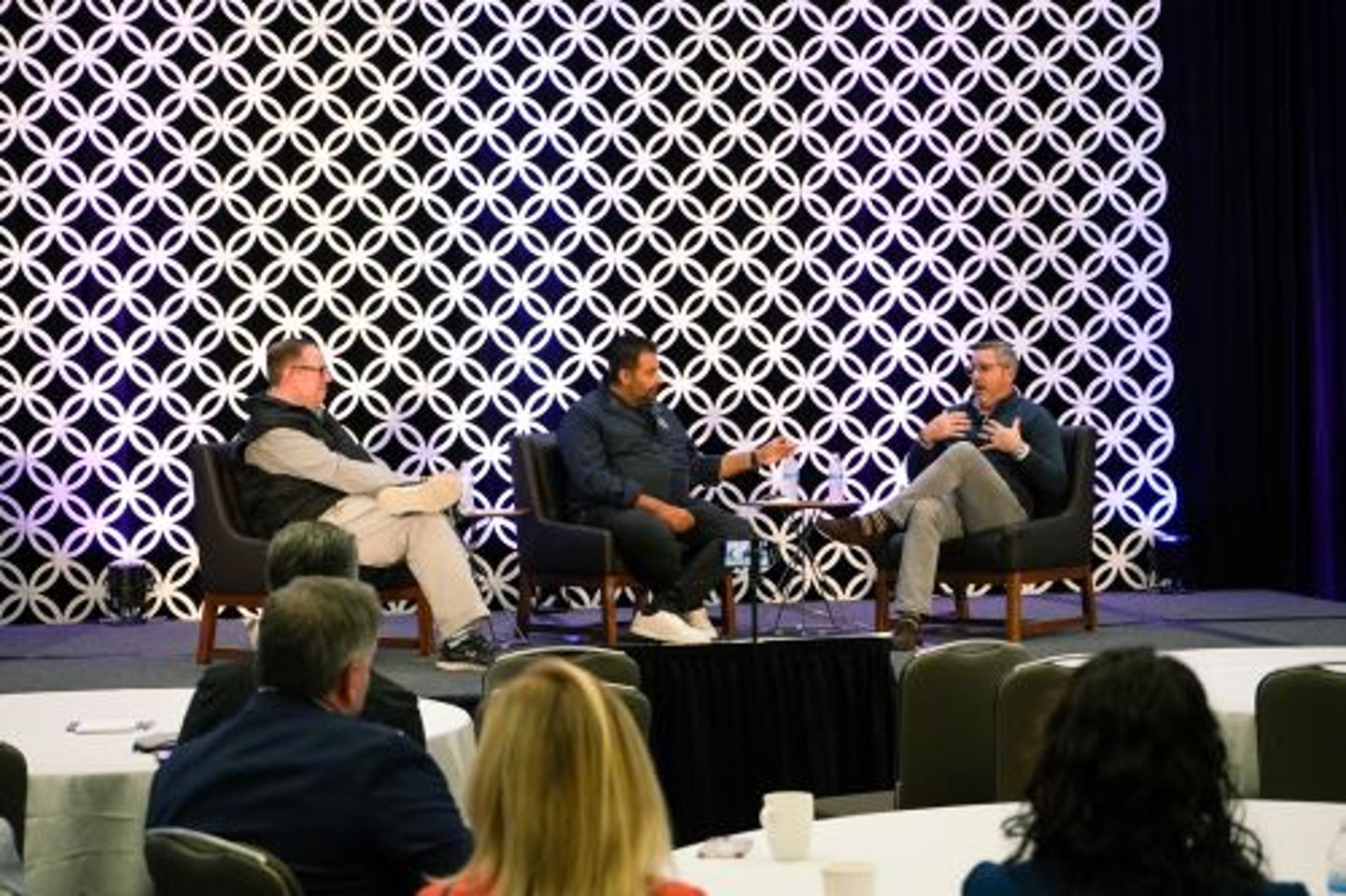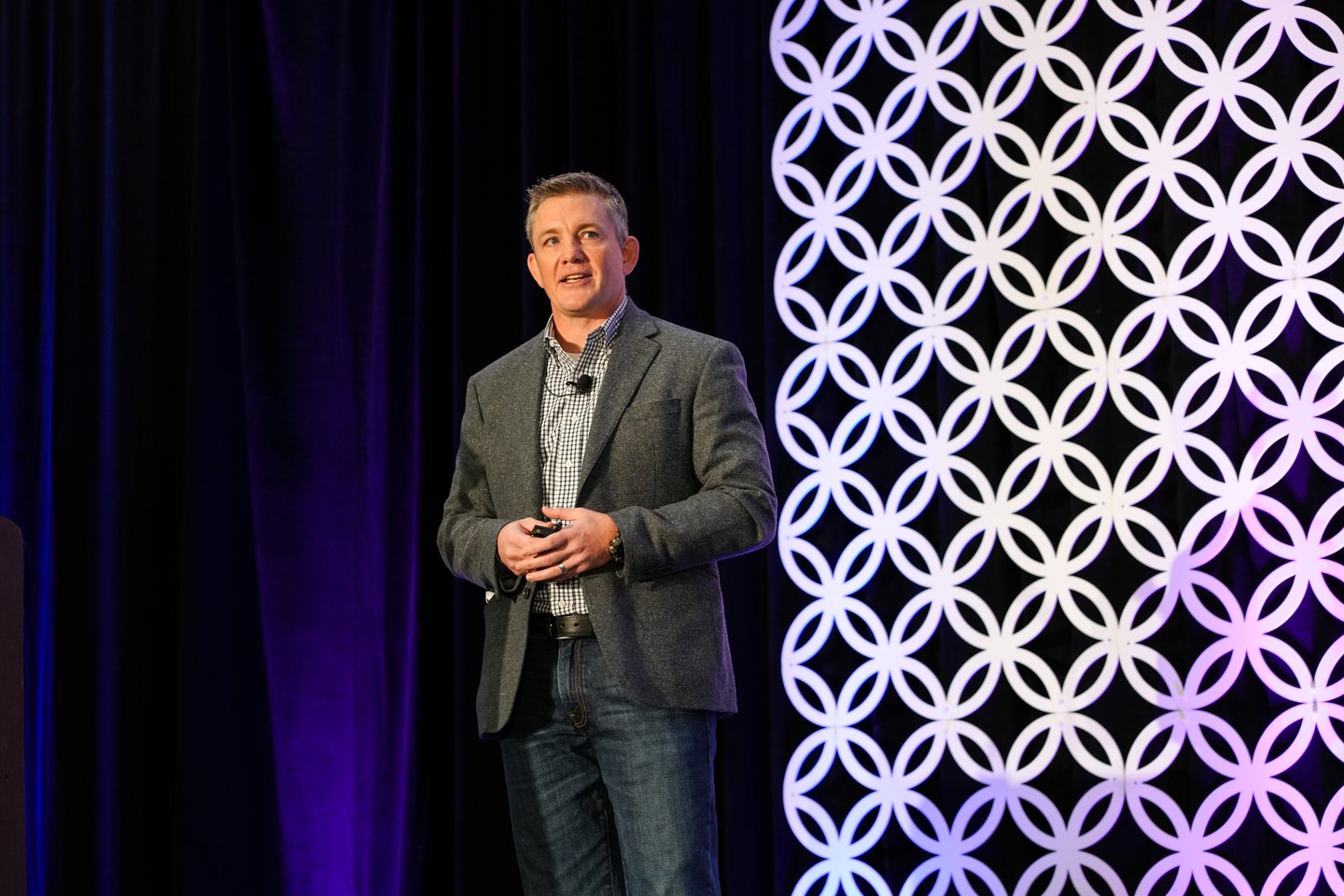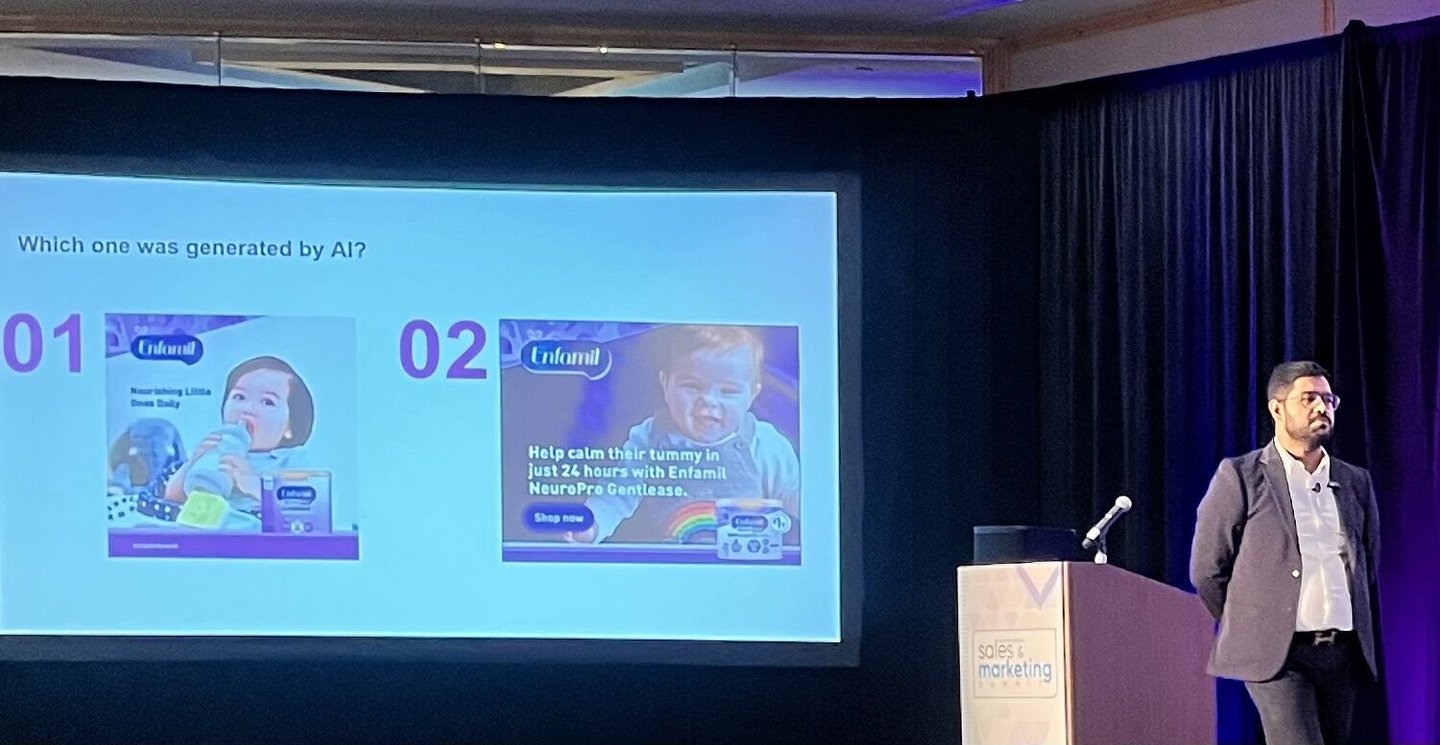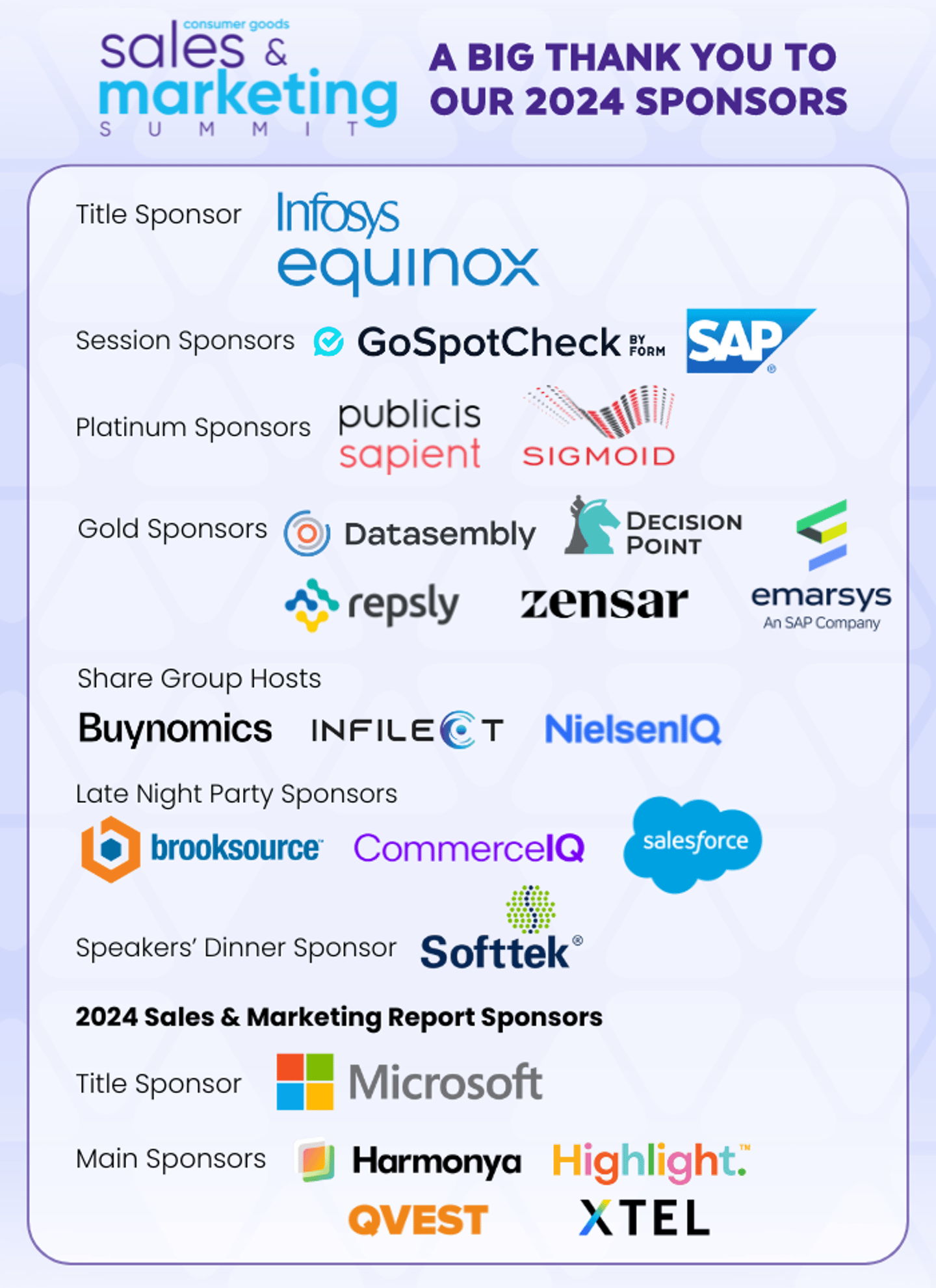Strategic Alignment at the 2024 Sales & Marketing Summit
The Consumer Goods Sales & Marketing Summit concluded in late September, bringing together top consumer goods experts and leaders to explore the theme "Raising New Cultures of Measurement."
Held in Princeton, NJ, from September 23-25, the Summit spanned three days of insights and best practices focused on evolving metrics, aligning business objectives, and leveraging technology to drive key performance indicators.
We’re excited to share key highlights from the sessions below, along with links to our expanded coverage.
CPG Guys Kick Us Off
Campbell’s Navigates Choppy CPG Waters By Digitalizing Efforts
The consumer goods space is filled with give-and-takes — a game of strategy, relationship-building, and balance. From dedicating time to both physical and digital commerce to building trust and transparency with both consumers and retailers, it’s a landscape filled with unique challenges. To keep up, CPGs are having to get sophisticated about digitalizing their efforts.
During the opening session, hosted by the co-founders of the CPG Guys podcast Peter Bond and Sri Rajagopalan, Mike Pierson, SVP and chief customer officer of snacks at the Campbell Soup Company, shared that threading the needle between physical and digital commerce remains a challenge — with areas like retail media akin to navigating rough white-water rapids.
“It has to be seamless,” said Pierson, regarding aligning digital and in-person experiences.
Share Groups
Building Your RGM Strategy for 2025 and Beyond
During this share group, hosted by Buynomics, participants engaged in a collaborative exercise to identify current challenges facing CPG brands and strategic solutions within RGM for overcoming them. Attendees touched on several areas, including retailer relationships, omnichannel management, and technology and data.
While challenge areas varied, attendees found that balance in strategy is key due to the interconnected nature of cost pressures, retailer dynamics, and consumer behavior, all of which require adaptive strategies from CPG brands. Equally as important is using technology to define KPIs and optimize trade and marketing investments.
The Fab Five of Omni — Examining 5 Big Bet Trends that Will Have Implications for Omnichannel Strategies
In this workshop-style session led by Kim Cox, NielsenIQ managing director, omni-commerce, participants explored five key trends shaping the future of omnichannel strategies, considering tactical and practical strategies that will or will not work in today’s digital landscape.
They identified shifts in consumer behavior, channel fluidity, private label competition, digital transformation, and personalization tactics as key areas of focus. Overall, consumer preferences have shifted, embracing social commerce-driven impulse buying but also value over brand.
Maximize In-Store ROI: Leveraging AI and Image Recognition for Picture-Perfect Profits
Led by Infilect’s VIjay Gabale, co-founder and chief product officer, and Amisha Sethi, VP of global marketing and customer relations, share group participants were privy to a deep dive into image recognition technology and how it can potentially impact the CPG industry when it comes to alleviating today’s most significant retail execution challenges.
Over a span of 90 minutes, the Infilect team showcased the myriad benefits of the technology, highlighting use cases and engaging with attendees for their perspectives.
As part of this, a fireside chat among Gabale, Sethi, and Tiran Avdar, global director, routes-to-market solutions at SAP Consumer Product Industry Business Unit, dug deeper into the broader challenges and opportunities surrounding image recognition.
Sessions
How Estée Lauder Is Cultivating a New Culture of Measurement With AI
As the keynoter, Raheel Khan, SVP of foresight and growth intelligence at The Estée Lauder Companies, shared how the multi-billion-dollar corporation leverages AI to drive teams toward growth and innovation, blending "math and magic" to establish a new culture of measurement.
Khan emphasizes the importance of blending analytics and creativity, referring to this combination as “math and magic.” The "math" involves using generative AI for analytical tasks to enhance time efficiency. He notes that accessible AI solutions can significantly boost productivity without requiring extensive IT infrastructure.
Read the extended coverage to find out about the magic component.
Key Strategies for Real-Time Omnichannel Measurement
The rapid evolution of mobile technology, social media, and AI has created opportunities for brands to engage with customers across various channels and business models. Yet, many companies face constraints due to an onslaught of multi-channel data and limited IT budgets and tech resources, making channel-specific strategies with real-time measurement essential.
“It's an increasingly connected world. You have to be the customer's ecosystem. That's why I've actually moved on from the omnichannel word, and I call it connected commerce,” said Gurmeet Singh, chief digital and data officer, ex-Gap and 7-Eleven, during the recent session presented by Infosys Equinox.
While e-commerce overall might require a more structured measurement approach, Conair CIO Jon Harding said that sometimes there’s a need to invest in new initiatives despite uncertain outcomes.
Think Like a Bee: Designing and Deploying AI Within Organizations
Cory Knopp of GoSpotCheck by FORM, who moonlights as a bee-keeper, shared the parallel pathways he's captured in his dual roles. The No. 1 piece of advice: Don't start by making honey. AI is complex and requires a strong foundation.
When building AI systems, Knopp emphasized three key factors: understanding how AI models are trained, using test environments, and maintaining data accuracy. Just as bees use a single hive for multiple purposes, companies should maximize the value of their AI systems to improve accuracy and efficiency across the enterprise.
Knopp also stressed the importance of data accuracy and cleanliness, comparing it to the fastidious way bees maintain their hive. Projects with well-maintained data have a 70% higher success rate, but trillions of data points are lost annually as a result of poor quality, leading to incorrect decisions.
“High-quality input leads to high-quality output,” he said. “From a bee perspective, it’s about the whole hive doing their specialty roles and capturing a high quantity of high-quality data.”
CPGs should create specific roles for AI — similar to how bees in a hive have specialized tasks. Whether it's automating customer service, improving logistics, or enhancing data analysis, each AI implementation should be tailored to a distinct purpose within the organization.
“You should be thinking about that same structure in AI implementation to touch as many people in your organization as possible,” said Knopp. “How can we extract the most value across the organization to improve accuracy and operational efficiency?”
Sustainable Profitable Growth: What Really Matters?
As consumer goods companies move from scaling to profitability, many are finding the need to rethink their revenue growth management (RGM) strategies. Winnie Albornoz, director of product marketing at SAP Commerce Cloud, took attendees through an exploration of the challenges and opportunities surrounding today’s RGM tools and tactics.
“A lot of people think growth can’t happen without the expense of profit, but both can happen, and both are critical,” she noted.
Albornoz ran through a framework that integrates technology to fuel profitability, built upon three pillars: connected enterprises, digital self-services, and artificial intelligence. As part of this, she outlined multiple case studies illustrating the benefits that can be had.
For example, Penti is recording 30% increases in basket sizes thanks to its work to deliver unified commerce experiences. Nestle’s investment in digital self-services has meant there are 15,000 global managers on one common solution, resulting in 10x faster deployment of digital assets. Aldo Group is improving product discovery and increasing customer loyalty with the use of AI.
When CPGs connect operational and contextual data together, they can unlock a host of insights that are not just based on what their customers like but how they operate, Albornoz noted.
Ultimately, success comes down to empowerment: empowering employees with a connected enterprise, empowering customers with digital self-service, and empowering the customer experience with AI.
The Holy Grail of Holistic E-commerce
Measuring digitally influenced sales remains a perennial challenge, and it’s only grown more complex as channels merge and consumers evolve. While it’s critical for CPGs to have everyone singing off the same sheet of music, getting them in tune can be a Herculean effort.
Andy McKeon, director, omnichannel business development at The Kraft Heinz Company, and Sonia Sethi, VP digital commerce and emerging channels at The Coca-Cola Company, talked about what’s needed to have all functions thinking through the omnichannel lens.
“It’s a team sport to think about every consumer through the path to purchase,” said Sethi. “Are we thinking about how her needs and motivators are different in an in-store and online environment?”
McKeon noted that today’s consumers are more informed than ever before, which has required them to really expand what’s tracked and measured.
“We’ve taken a strong approach to be very inclusive during key moments that are impacting key consumers. … We’re trying to make sure that we understand what points are working for our consumer and where we can optimize,” he said.
When it comes to success, the companies getting this right are the ones taking integrated business planning to heart, said Sethi. “Very practically speaking, having executive-level prioritization of omnichannel as a way of doing business is absolutely imperative. It can make or break a team’s success.”
How Colgate-Palmolive Is Bridging Gaps in the Complicated Retail Media Landscape
Everyone wants a piece of the pie when it comes to retail media.
Amid channel erosion due to television ratings in decline, and the battle for insights intensifying as third-party cookies take a hit, CPGs are looking for improved ways to effectively reach consumers and identify valuable shopper behavior patterns through advertising data.
While the concept is simple — it’s just media sold by retailers, said Vivek Rastogi, senior director, global digital commerce, Colgate-Palmolive — it’s the relationship pivot between CPGs and retailers that’s introducing complexities.
How Kellanova, Kenvue & PepsiCo Use Digital-First, Consumer-Centric Personalization
With consumer goods marketing often aligned with traditional retail operating models, many organizations struggle to adopt genuinely consumer-centric strategies.
According to industry leaders Emily Minardi (Kellanova), Channan Sawhney (Kenvue), and Ellen Webb (PepsiCo), many of the largest CPGs are shifting to create dynamic and sustainable operating models. They are effectively navigating digital transformation challenges by using advanced technologies and data analytics to foster deeper, more personalized connections with consumers.
“Data that we have now allows us to connect with the consumer in a much more personalized way, and I think we're realizing more that's the way we’re adjusting, so it’s exciting,” said Minardi, senior director of consumer experience enablement.
CG Tech Experts Weigh in on Sales and Marketing Investment Trends
Sales and marketing teams are undergoing significant transformations to adapt to evolving consumer preferences. Dynamic organizations are re-evaluating their technology investments to transition from reacting to change to predicting it.
According to CGT’s recent Sales and Marketing Benchmark Research Report, experts believe that TPM, TPO, e-commerce, retail media, and social media marketing will significantly shape the industry. Strategies positioned for the greatest impact include influencer marketing, social shopping, and hyper-personalization — with many of these using generative AI.
Technology experts from Microsoft, Publicis Sapient, and Sigmoid share that understanding how to leverage consumer data effectively, and how to accurately measure success, will be crucial for maximizing these strategies.
“I’m a huge believer that if you don't measure things, if you don't monitor them, if you don't honor them, you cannot enact change. And how many of us are actually measuring and monitoring in order to enact that change, and how do we remove our blind spots through the use of technology?” panelist Doug Adams, general manager of business applications at Microsoft, posed.
GenAI: The New Sidekick to Every Creative Genius
While it’s been often said that generative AI is like teenage sex in that everyone is talking about it but no one is doing it, Imteaz Ahamed, head of performance marketing, nutrition, at Reckitt, stressed that the reverse has actually become true: “Generative Al is not like teenage sex; it's quite easy to deploy, and yes, everyone is doing it.”
What’s more, if you’re not doing it, you’ll be left behind.
With that, he showcased how the Reckitt e-commerce content team is leveraging the technology to lower the cost per asset and increase the conversion rate of assets. This included:
- Tagging all display media assets at scale using generative AI
- Connecting to a DSP
- Feeding data to the generative AI model to understand what’s working
- Mapping content production workflows
- Upskilling team members to understand where the tool is helping
- Adding features to export editable files as an output so design teams can adjust the creative
While the images aren’t yet being used with consumers, Ahamed said they anticipate this workflow will more than halve the amount of hours of work required.
To prove his point about their effectiveness, he quizzed Summit attendees on whether they could discern the differences between AI- and human-generated images. Even as a crowd of season AI expects, most were unable to tell the difference.
AI in Action: Transforming Consumer Goods Marketing
Manju Madhavan, IT director, business partner, digital commerce and emerging technologies at Campbell Soup Company, and Todd Hassenfelt, global digital commerce senior director, strategy and execution at Colgate-Palmolive, continued the artificial intelligence conversations with a discussion about some of the ways their organizations are leveraging the technology, as well as the emerging learnings from the journey.
Like Ahamed, both Hassenfelt and Madhavan discussed the immense benefits that AI can bring to product content creation and image optimization. In order to maximize these benefits, however, gaining stakeholder buy-in remains the most important piece of the puzzle.
Madhavan noted that Campbell’s has been undergoing a digital transformation that has resulted in significant improvements to their data foundation platforms. This has enabled them to further activate more use cases, including surrounding recipe personalization within their meal segment to improve the consumer experience.
For Colgate-Palmolive, bringing the designers who have created the content to work in tandem with the commerce teams has meant testing, testing, testing.
“Find the group that has a stretch project, and get your test-and-learn process down. Then hopefully they’re advocates for you, and you get markets to build with,” he said. “You have to amplify results within the organization: ‘Here’s where we are. Here’s where we go. Here are the resources we need.’”
Closing Keynote: Evolving to a Fit-for-Channel Culture
Surabhi Pokhriyal, chief digital growth officer at Church & Dwight, emphasized the importance of designing products and strategies tailored for specific sales channels, rather than relying on a one-size-fits-all approach.
The company has shifted its thinking, moving away from simply pushing products on platforms like Amazon and hoping for success. One of the key opportunities is the rapid adoption of AI over the last 18-20 months.
A fit-for-channel culture requires a mindset shift, particularly in understanding new retail metrics. Traditional measures like ROAS may not always apply in the context of retail media, making it necessary to adapt quickly and rethink how success is measured.
Also, with a lean team structure, employees wear many hats, and there’s intentional talent rotation — digital shelf experts can become omnichannel experts, for example. This agile, cross-functional approach ensures teams are always learning and unlearning, with a safe space to admit mistakes and grow from them.
Innovation Sprint: ‘Productionizing’ Efforts and Making Messaging Stick
At the Summit's inaugural Innovation Sprint, led by Trend Hunter’s Jennifer Kang, attendees were challenged to rethink how they approach creativity. The workshop focused on "productionizing" innovation, adhering to the Kindergarten rule: any idea must be simple, easy to understand, and memorable — essentially, it has to “stick.”
The session was fast-paced, buzzing with energy as CPG executives collaborated to fine-tune their creative processes. Kang introduced methodologies designed to push participants beyond their comfort zones, encouraging them to replicate what resonates with their consumers.
The emphasis was on crafting compelling ideas, and continuously refining headlines that were seven words or less until it achieved three pillars for story obsession:
- Simple and builds momentum
- Answers the question, “Why should I care?”
- Supercharged and supports socialization and recall
The last portion of the workshop tasked attendees with creating a narrative and tagline for an imaginary pen product that was ready to ship. A key takeaway was the importance of understanding your audience. Kang emphasized, “How well you understand your audience can be your biggest asset or your biggest liability.”
The Innovation Sprint pushed participants to refine their ideas and make their messaging more impactful — teaching them how to better communicate and connect with consumers in meaningful, memorable ways.
Cocktails, Chats, and Collaboration
The Summit offered abundant networking and socializing opportunities, fostering meaningful connections among industry professionals. One of the standout events was the Power Hour, where attendees engaged in one-on-one networking sessions, facilitating personalized conversations with key leaders and peers.
For those seeking more targeted discussions, the Topic Tables provided a great platform for small group interactions on specific subjects relevant to the industry.
A highlight of the Summit was the celebration of Ann Dozier, CIO of Southern Glazer's Wine & Spirits, as she was honored as CGT’s 2024 CIO of the Year. The event allowed participants to connect with Ann and gain valuable insights from her leadership and IT journey.
To top it all off, the Summit’s late-night party provided a relaxed environment to unwind and socialize, reconnecting with old friends and forming new professional bonds in a fun, casual setting.












